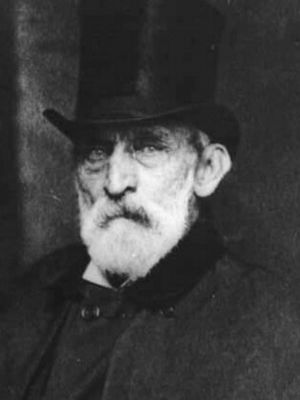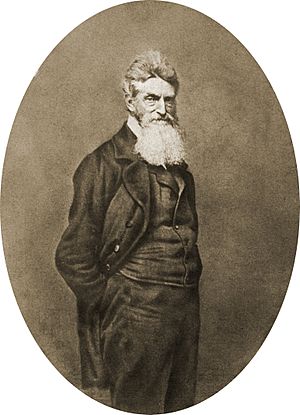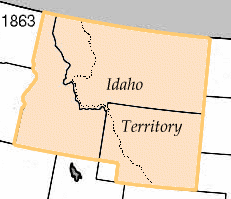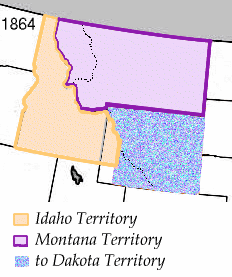Sidney Edgerton facts for kids
Quick facts for kids
Sidney Edgerton
|
|
|---|---|
 |
|
| 1st Territorial Governor of Montana | |
| In office June 22, 1864 – July 12, 1866 |
|
| Appointed by | Abraham Lincoln |
| Preceded by | office established |
| Succeeded by | Thomas F. Meagher Acting Territorial Governor |
| Chief justice of the Idaho Territorial Supreme Court | |
| In office March 1863 – 1864 |
|
| Preceded by | office established |
| Succeeded by | Silas Woodson |
| Member of the U.S. House of Representatives from Ohio's 18th District | |
| In office March 4, 1859 – March 3, 1863 |
|
| Preceded by | Benjamin F. Leiter |
| Succeeded by | Rufus P. Spalding |
| Personal details | |
| Born | August 17, 1818 Cazenovia, New York, US |
| Died | July 19, 1900 (aged 81) Akron, Ohio, US |
| Resting place | Tallmadge Cemetery, Tallmadge, Ohio |
| Political party | Free Soil (1848–1856) Republican (1856–1900) |
| Spouse | Mary Wright Edgerton |
| Children | Martha Edgerton Rolfe Plassmann |
| Profession | Politician, Lawyer, Judge, Teacher |
Sidney Edgerton (born August 17, 1818 – died July 19, 1900) was an important American politician, lawyer, judge, and teacher from Ohio. He played a role during the American Civil War. Edgerton served as a U.S. Congressman. In 1863, Abraham Lincoln chose him to be the first Chief justice of the Idaho Territorial Court. Edgerton worked hard to create new territories from the Idaho Territory. In 1864, President Lincoln appointed him as the first Territorial Governor of Montana. After his time as governor, Edgerton returned to Ohio and continued his law career until he passed away in 1900.
Contents
Early Life and Education
Sidney Edgerton was born in Cazenovia, New York, on August 17, 1818. His parents were Amos and Zerviah Edgerton. Sidney's father, Amos, was a teacher who became blind and died when Sidney was very young. His mother, Zerviah, had to raise six children by herself.
By the age of eight, young Sidney started working to help pay for his schooling. He later attended the Genesee Wesleyan Seminary in Lima, New York. His cousin taught there, and Sidney later became an instructor at the same school.
Starting His Career
In 1844, Edgerton moved to Ohio. He began working in a law office and also taught at an academy in Tallmadge, Ohio. He studied law and graduated from the Cincinnati Law School in 1845. The next year, he became a lawyer and started his own law practice in Akron, Ohio.
In 1848, Sidney married Mary Wright.
A Career in Politics
Edgerton was a delegate, or representative, at the meeting that created the Free Soil Party in 1848. This party was against the spread of slavery into new territories. From 1852 to 1856, he served as the prosecuting attorney for Summit County, Ohio.
In 1856, Edgerton was a delegate at the very first Republican National Convention. The Republican Party was also against slavery. That same year, he was asked to be a judge, but he said no. In 1858, Edgerton was elected as a Republican to the United States House of Representatives.
Helping End Slavery
Edgerton started his term in the House of Representatives in 1859. He was a strong abolitionist, meaning he wanted to end slavery completely. He often spoke out against slavery in Congress.
After John Brown's raid on Harpers Ferry, John Brown's family asked Edgerton to help with Brown's affairs. This was a very risky thing to do because Edgerton was known for being against slavery. Edgerton traveled by train to help.
When he arrived, he was told that only John Brown's family and a minister could visit him. Edgerton was not allowed to see Brown. He then had to travel back to Washington, D.C. During his journey, he faced some challenges but eventually made it out of Virginia safely. After this experience, Edgerton continued to be a strong voice in the anti-slavery movement. He decided not to run for re-election in 1862.
Serving During the Civil War
During the Civil War, Edgerton briefly served as a colonel in the Ohio Militia. He was part of a group called the "Squirrel Hunters," who were skilled shooters from Ohio. They helped defend Cincinnati, Ohio. Edgerton served as both a U.S. Congressman and a soldier during the early years of the war.
The Idaho Territory
In 1863, President Abraham Lincoln appointed Edgerton to be the Chief Justice of the Territory of Idaho. His salary was $2,500 a year. He traveled west with his family and friends. Their journey involved trains, boats, and ox-drawn wagons. They faced good weather and no major problems with Native Americans.
One time, Edgerton fell from a wagon and was almost run over by a wheel. They arrived at South Pass in August 1863. They learned that the capital of the Idaho Territory was to be Lewiston. However, they realized they couldn't reach Lewiston before winter snows. So, they changed their route and headed for Bannack. They crossed the Snake River by ferry and met Sheriff Henry Plummer. The group finally reached Bannack on September 16.
After arriving in Bannack, Edgerton found that there was no official way for him to take his oath of office as Chief Justice. He and his family bought a home for $400, which became the first Montana Governor's Residence. Edgerton toured the local gold fields and saw how valuable they were to the Union during the war.
The local people chose him to go to Washington D.C. His mission was to ask for the Territory of Idaho to be divided. Edgerton arrived in Washington with $2,500 in gold nuggets, which he showed to President Lincoln and members of Congress. His efforts worked! In 1864, the Territory of Idaho was split into three parts: the Territory of Idaho, the Territory of Montana, and the Territory of Dakota.
Governor of Montana
Before leaving Washington, D.C., Edgerton had a private meeting with President Abraham Lincoln. He asked to be the Territorial Governor of Montana. Lincoln said he would consider it. On May 23, 1864, while Edgerton was on his way home, his wife Mary had a baby girl. They named her Idaho, not knowing that the area was now called the Territory of Montana. Because of his good work in the Idaho Territory, President Lincoln appointed Edgerton as the first Territorial Governor of Montana.
Lincoln made the appointment on June 22, 1864. Edgerton found out when he arrived back in Bannack. Bannack became the capital of the Montana Territory, so the Edgertons were able to keep their home. Edgerton faced some challenges because many settlers and miners had different political views than he did.
Edgerton quickly organized a census so that elections could be held. These elections were for the State Council, State House, and for the territory's representative in the U.S. House of Representatives. After the 1865 elections, the Democrats gained power in the House and won the representative seat. However, the Republicans won the Council. Even with disagreements, the legislature worked with Edgerton to pass many laws about roads, public education, irrigation, and mining.
In 1865, Edgerton also had to deal with challenges from Native Americans. General Patrick Connor was sent to help. He led an expedition against some Sioux and Cheyenne Indians who were causing problems for travelers along the Bozeman Trail. Edgerton then asked for five hundred volunteers to help protect immigrants. Other agreements and treaties were made between the Government of the Territory of Montana and the Native Americans.
In 1865, Edgerton had to travel East to get money for the territory. The territory wasn't making enough money to cover its costs, and Edgerton had even used a lot of his own money to help. He hoped to get funds for the territory and be paid back for his expenses, but he received neither. Edgerton left the Territory in September 1865. While he was away in Washington, D.C., Thomas Francis Meagher served as the acting Territorial Governor of Montana. Edgerton remained governor until January 13, 1866, but he did not return to Montana for 25 years. To show their feelings about Edgerton, the state legislature changed the name of Edgerton County to Lewis and Clark County.
Later Life and Legacy
After returning to Akron, Ohio, with his family in the Fall of 1865, Edgerton went back to his law practice. He continued working as a lawyer until his death on July 19, 1900. He is buried in Tallmadge Cemetery in Tallmadge, Ohio.
Images for kids





